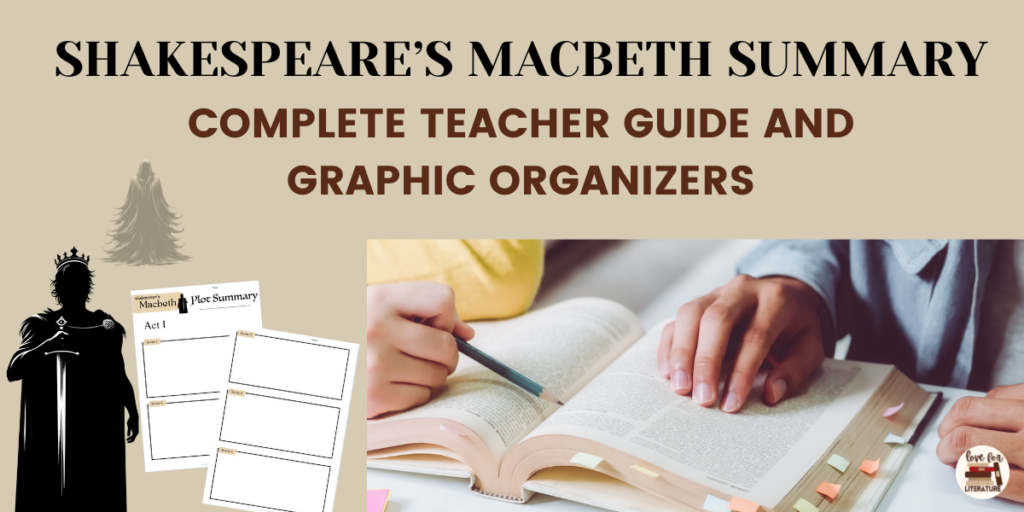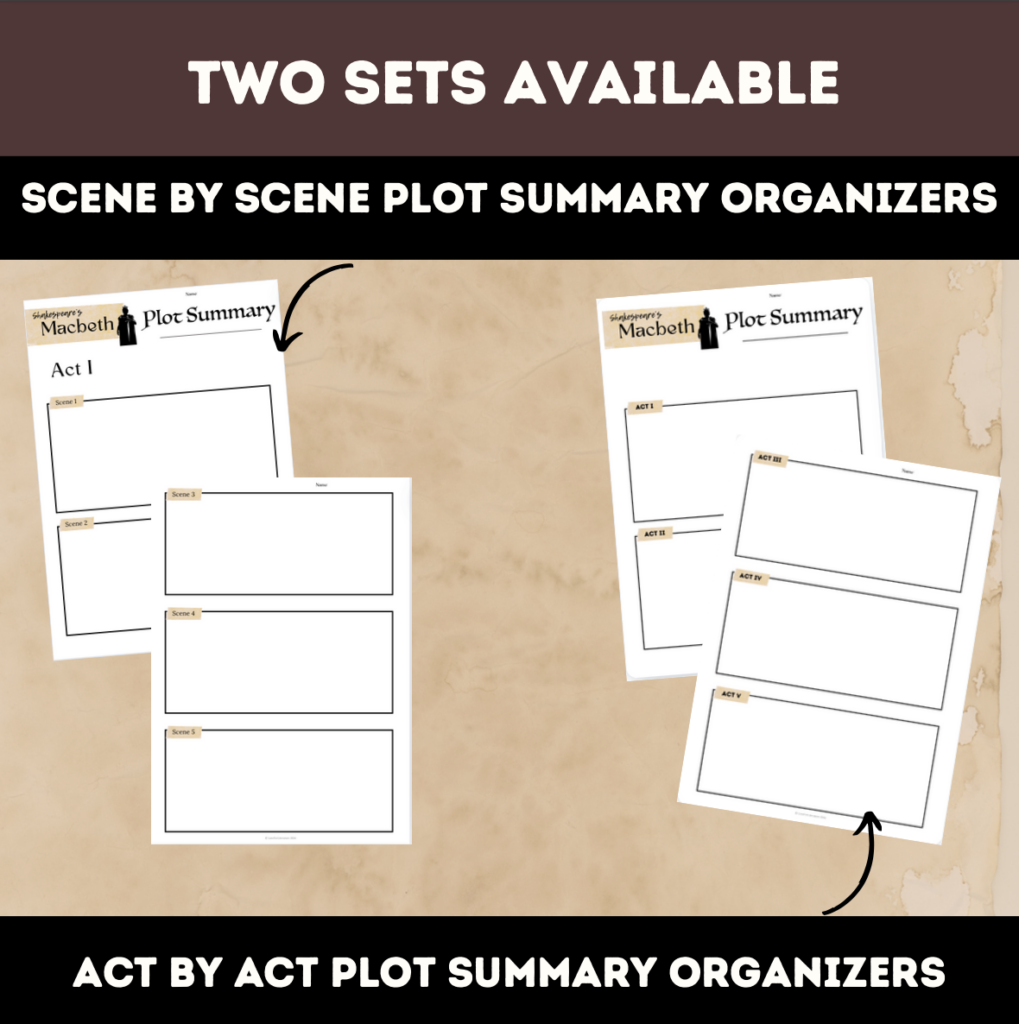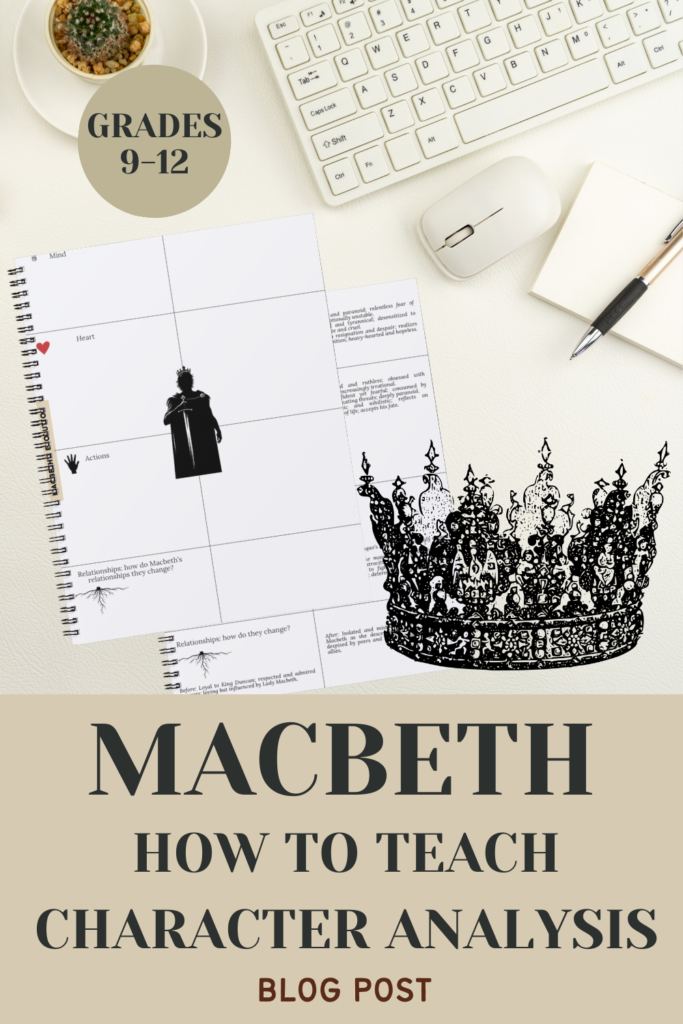Tackling Shakespeare’s Macbeth summary is the first, essential step to helping students truly engage with the play. Between the cryptic language, shifting loyalties, and supernatural twists, it’s easy for them to miss the brilliance of the story.
Thank you for reading this post, don't forget to subscribe!That’s why starting with a strong summary matters so much. When students can see the bigger picture—what’s happening, who’s driving the action, and why it matters—they’re more likely to stay curious, make connections, and engage deeply.
I created these graphic organizers to support exactly that: helping Grades 9–12 students process Shakespeare’s Macbeth summary in a way that’s visual, interactive, and meaningful. Learning to summarize is all about building a foundation that empowers more critical and richer thinking later on.
But first, let’s go through Shakespeare’s Macbeth Summary act by act and highlight some of the most important themes and character developments this play has to offer in a more advanced discussion stage of the study.

Act 1: Seeds of Ambition
Macbeth, Scotland’s noble general, returns from war a hero. But when he encounters the three witches, everything changes. They prophesy that he will become king. That seed of ambition is quickly watered by Lady Macbeth, who pushes him to act on the prophecy.
What to know about this act (Key developments):
- Macbeth starts as brave and loyal but is clearly shaken by the witches’ prediction.
- Lady Macbeth emerges as a powerful influence, more resolute and ruthless than her husband.
- The idea of fate vs. free will is introduced, along with the corrupting nature of unchecked ambition.
- The supernatural sets the tone for the rest of the play.
Act 2: The First Betrayal
Macbeth murders King Duncan in his sleep to fulfill the prophecy. Though Lady Macbeth plans the details and calms her husband’s nerves, it is Macbeth who carries out the deed.
What to know about this act (Key developments):
- Macbeth crosses a moral line and immediately feels the psychological toll: paranoia, guilt, and fear.
- Lady Macbeth initially appears stronger and more collected, telling him to wash away the guilt.
- The imagery of blood and darkness becomes central.
- This is the turning point where ambition overtakes honor.
Act 3: Paranoia and Power
Macbeth, now king, feels insecure about Banquo’s prophecy—that Banquo’s descendants will be kings. So he plots Banquo’s murder and, by extension, tries to defy fate itself. Banquo is killed, but his son Fleance escapes. At a banquet, Macbeth is haunted by Banquo’s ghost.
What to know about this act (Key developments):
- Macbeth becomes more independent and ruthless, acting without consulting Lady Macbeth.
- His paranoia and fear of losing power are now guiding his decisions.
- Banquo’s ghost symbolizes Macbeth’s guilt and the psychological consequences of betrayal.
- Lady Macbeth begins to lose her grip on Macbeth and the situation.
Act 4: Descent into Tyranny
Macbeth visits the witches again. They offer him new prophecies: beware Macduff, no one born of a woman can harm him, and he is safe until Birnam Wood comes to Dunsinane. Macbeth, now overconfident, orders the slaughter of Macduff’s family. Lady Macbeth begins to unravel.
What to know about this act (Key developments):
- Macbeth has become a tyrant, committing atrocities with no remorse.
- The witches’ riddles give him false confidence, reinforcing the theme of deception.
- Lady Macbeth, once the driving force, is now emotionally fragile and guilt-ridden.
- The contrast between appearance and reality becomes even more central.
Act 5: Collapse and Consequence
Lady Macbeth, plagued by guilt, sleepwalks and reveals her crimes. Meanwhile, Malcolm’s army disguises themselves with branches from Birnam Wood, fulfilling the witches’ prophecy. Macduff, revealed to have been born via C-section (not “of woman born”), kills Macbeth in battle.
What to know about this act (Key developments):
- Lady Macbeth’s guilt drives her to madness and ultimately her death.
- Macbeth, though defiant, realizes he has been misled and faces death with a mix of pride and despair.
- The witches’ prophecies come true, but not in the way Macbeth expected.
- Order is restored with Malcolm’s victory, highlighting the consequences of unchecked ambition and betrayal.
Help Students Own the Story of Macbeth
Shakespeare’s Macbeth summary doesn’t have to feel like a confusing puzzle. With the right structure in place, students can build their understanding piece by piece—and actually enjoy the process.
These graphic organizers are more than just worksheets. They’re scaffolds that support thinking, build engagement, and encourage ownership of learning.
If you’re looking to make your Macbeth unit more effective (and a little less chaotic), this can be a great resource and just what you need.
How to Use These Organizers in Class
You can use these tools in so many flexible ways, depending on your schedule and goals:
🟡 Before Reading: Use the character map and prediction prompts to build curiosity.
🟢 During Reading: Fill out act summaries and theme trackers as you go.
🔵 After Reading: Use completed organizers as a launchpad for essays, discussions, or creative responses.
Even better? These organizers work well for independent work, group projects, or whole-class guided analysis. If you use digital platforms, they can easily be adapted for online learning, too.
Why Use Graphic Organizers to Teach Macbeth?
Macbeth starts as brave and loyal but is clearly shaken by the witches’ prediction.
Lady Macbeth emerges as a powerful influence, more resolute and ruthless than her husband.
The idea of fate vs. free will is introduced, along with the corrupting nature of unchecked ambition.
As we know, Macbeth isn’t just about kings and witches. It’s about power, guilt, fear, and fate—timeless themes that still resonate today. But before we can dive into the juicy discussions, students need a strong grasp of what actually happens.
Graphic organizers allow students to:
- Visually process each act and scene
- Track character development
- Analyze cause-and-effect moments
- Summarize key events with confidence
And let’s face it—when students feel like they understand the story, they’re more likely to engage in deeper analysis.
Ready to Bring These Organizers Into Your Classroom?
You can grab the full Macbeth Summary Graphic Organizer Pack for Grades 9–12 for $3.50 here. It’s printable, editable, perfect for both remote and in-class use.
Bring the brilliance of Shakespeare and his timeless themes into your classroom discussions today!
Check out my other Macbeth Resources...
If you’re looking to take your Macbeth unit even further, don’t miss our in-depth character guide “Macbeth in Macbeth: Character Analysis”, where we break down his psychological transformation scene by scene. For poetry lovers or those teaching Shakespeare’s sonnets alongside the plays, check out our analysis of Sonnet 116—a timeless meditation on love—and our creative Valentine’s Day classroom activity, Sonnet 18 + AI: Write a Love Poem with ChatGPT. Each post is designed to bring Shakespeare’s words to life and help students connect with them in new, personal, and powerful ways.








